Indian street food is considered by some to be the hidden gem of Indian cuisine. Most of the major cities in India such as Mumbai, Delhi, Kolkata, and Chennai boast ah-mazing street food dishes.
I personally love Indian street food because not only are the appetizer-sized portions ideal (which is a super important factor for finicky eaters like *ahem* me), but there is absolutely NO skimping on the flavor right down to the tiniest morsel. Once you find your go-to Indian street food snack, I promise you’ll go back for seconds…or thirds…or in my case, tenths because tapas > entrees.
DISCLAIMER: If you are traveling to India as a first-timer it is strongly advised to think twice before trying food from outdoor vendors mostly due to questionable sanitation standards. However it should also be noted that in recent years a plethora of five-star restaurants and hotel cafés have started to offer an array of street food-inspired menus that are more than perfectly safe for consumption.
Aloo Tikki (pronounced ah-loo tick-ee)
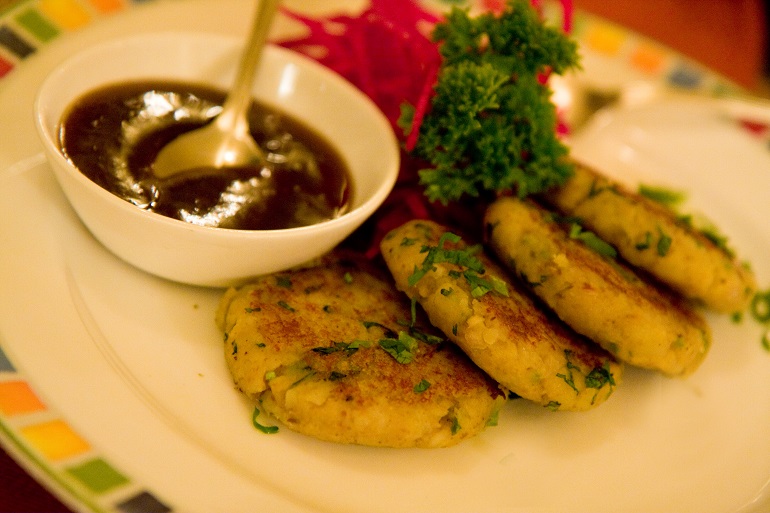
Photo courtesy of Garrett Ziegler on Flickr
This Indian street food item is the South Asian version of a potato croquette. Aloo tikki is prepared by mashing boiled potatoes-which are combined with coriander, onions, and special spices-and then shaping them into patties. Next, the patties are deep-fried to create a crispy outer layer while still remaining melt-in-your-mouth-soft on the inside.
These spicy potato cutlets are served with mint and/or tamarind chutney, yogurt sauce, or Maggi ketchup – a South Asian staple.
Bhelpuri (pronounced bh-ale poo-ree)
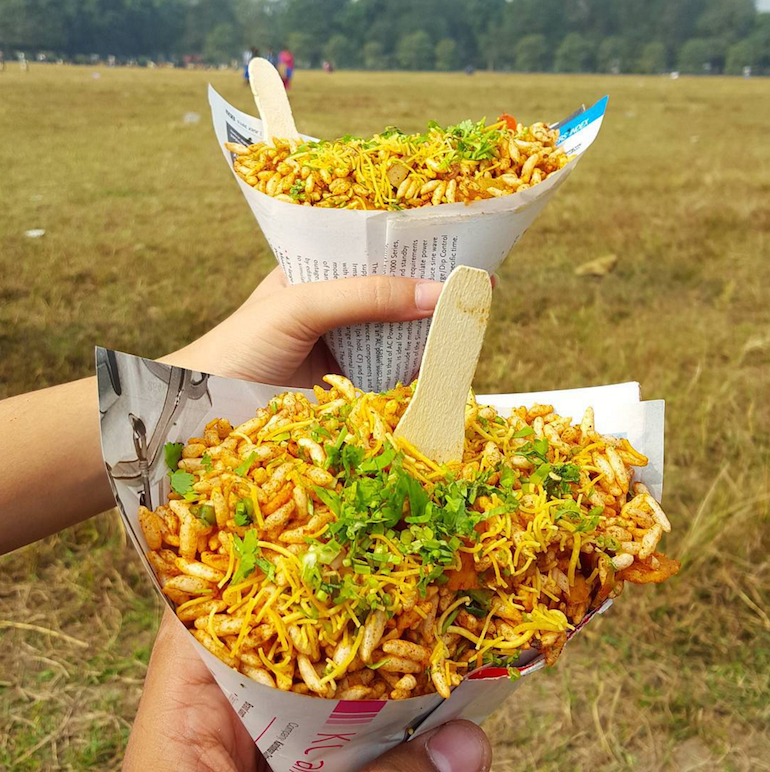
Photo courtesy of @culinary_diggers on Instagram
The best way to describe bhelpuri is like a flavor party in your mouth. After all, this West Indian regional street food is designed to meld sweet, salty, and spicy flavors into one tasty snack. And did I mention that bhelpuri is naturally vegan AND traditionally served in a paper cone?
*Ina Garten voice* How exciting is that?
Nowadays, bhelpuri is most commonly served as an appetizer at large dinner parties since it’s embarrassingly easy to make. All that’s necessary is to toss the pre-prepared ingredients into a large bowl and voila! These ingredients include puffed rice, sev (deep-fried noodles made from chickpea flour paste), chaat masala, diced onions, and tomatoes plus green chilies and cilantro as a garnish.
Chaat (pronounced chah-t)
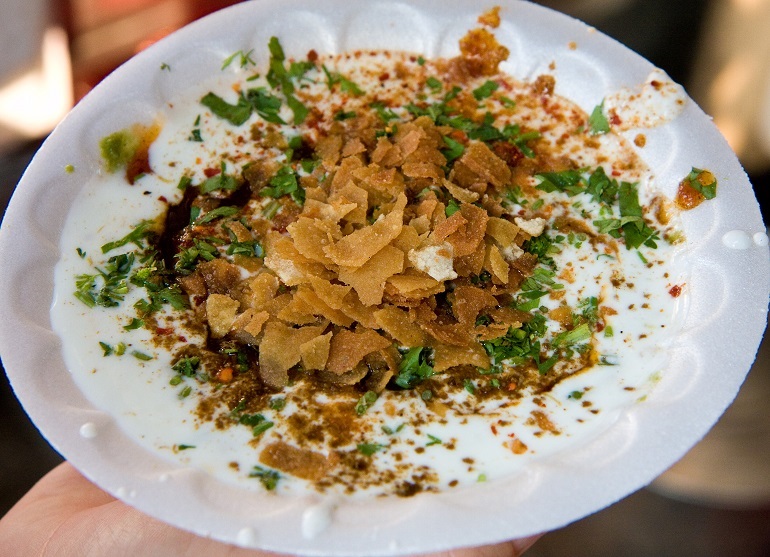
Photo courtesy of Garrett Ziegler on Flickr
Although this kind of Indian street food is most commonly found in North India and Pakistan, chaat is also a generic term for South Asian street food in general.
The dish consists of papri (thin pieces of fried dough) which are layered between boiled chickpeas, boiled potatoes, occasionally bean sprouts and a seasoned yogurt sauce. Depending on the type of chaat, other components can be added in such as aloo tikki and samosa. The dish is then garnished with tamarind chutney and sev.
Dosa (pronounced dho-saa)
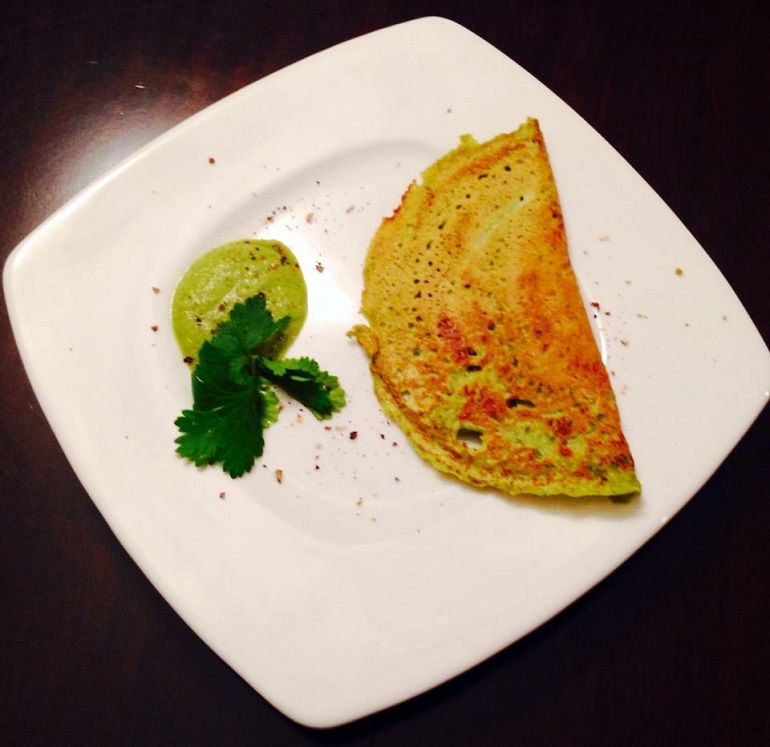
Photo courtesy of Suneeta Mishra
If you’re about that crepe life, this dish is for you. Dosas are crepes made out of a fermented batter of rice and black lentils. These savory crepes are an integral part of South Indian cuisine, so it is very common to find food stalls in various regions of India (with a strong South Indian demographic) that make dosas.
Dosas can be made plain or stuffed with a masala mashed potato mixture. Growing up I also remember one of our family friends stuffing the children’s and my cheese-fanatic mother’s dosas with shredded cheese – which bt-dubs tastes bomb af…so dosa purists don’t hate.
Typical chutneys that are served with dosas are coconut chutney and mint chutney. Milagai podi (colloquially known as gunpowder) mixed with gingelly oil is also a popular (and my personal favorite) dosa condiment of choice.
Kati Roll (pronounced kah-tee roll)
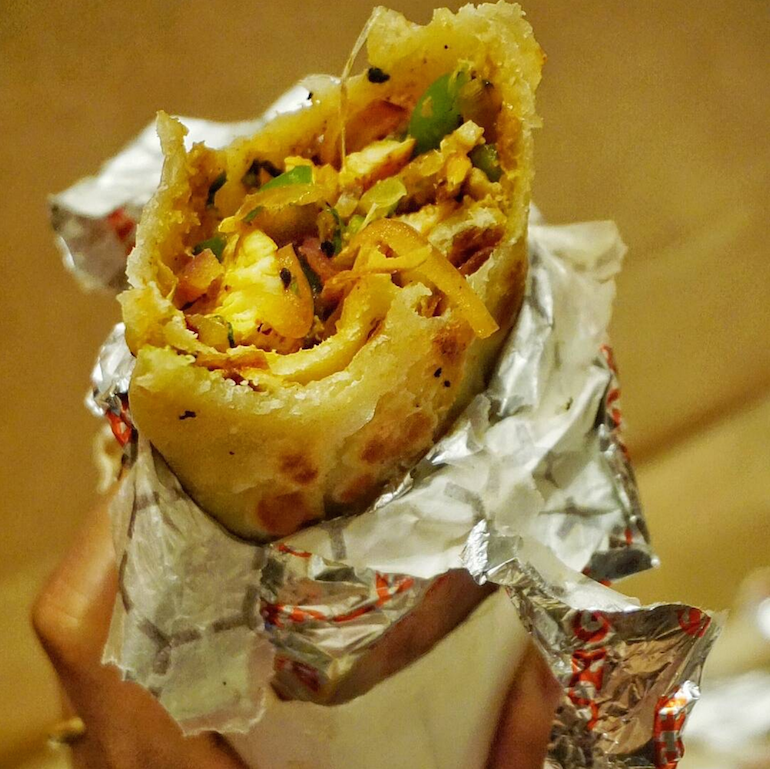
Photo courtesy of @fryingpanadventures on Instagram
Sure Chipotle burritos are bae and all, but have you ever sunk your teeth into a kati roll in the middle of lunch hour on the side of a busy intersection in the heart of Kolkata? Now that is truly an Anton Ego moment – at least for any native Kolkatan.
Kati rolls might be considered West Bengal’s equivalent of a burrito however a closer relative would be the frankie or even the shawarma (idk why I am using family metaphors but they work, so stay with me on this one).
It should be noted that the flavor profile of a kati roll is truly unique with its roti exterior which envelopes tender pieces of spiced chicken, lamb, or paneer in addition to toppings that range from scrambled eggs to mixed raw/cooked vegetables. The final garnishes before the vendor wraps up the roti are a variety of sauces, a squeeze of lemon or lime, and a sprinkle of chaat masala.
All I know is that every time I bite into one of these babies, the only sound that fills my ears is Edith Piaf’s “Non, je ne regrette rien” and I momentarily transcend into culinary nirvana. No, I regret nothing indeed Mademoiselle Piaf.
Kebab (pronounced as kuh-baab)
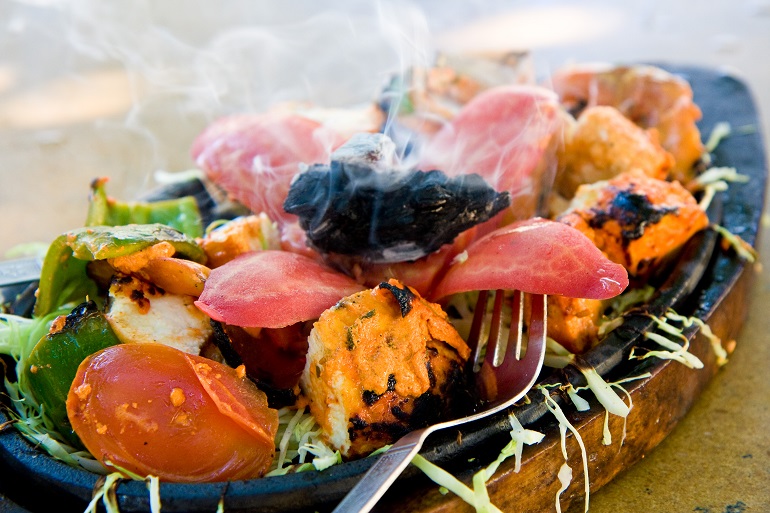
Photo courtesy of Garrett Ziegler on Flickr
Kebab is a Mediterranean/Middle Eastern/South Asian dish containing marinated pieces of meat or fish skewered along with a variety of vegetables (usually bell peppers and red onion) and roasted or grilled to evoke a charred flavor.
What makes Indian-style kebabs worth your time is they are guaranteed to make your taste buds freak out. Depending on which restaurant you go to, Indian-style kebabs are available in a variety of spice blends which range from spicy-ish to I-need-a-mango-lassi-because-my-mouth-is-spewing-fire spicy.
Generally, the least spicy kebab flavor is murgh malai, which roughly translates from Hindi to “tangy chicken.” The most popular kebabs, especially in the Western world, include chicken tikka (as pictured above) and chicken tangri.
Or if you’re like me and find chicken tikka and tandoori chicken to be mainstream-basically-borderline-cliche, step up your kebab game and check out seekh, shami, hariyali, and reshmi kebabs aka the kinda-sorta-hipsters of the Indo-kebab world.
Kulfi (pronounced cool-fee)
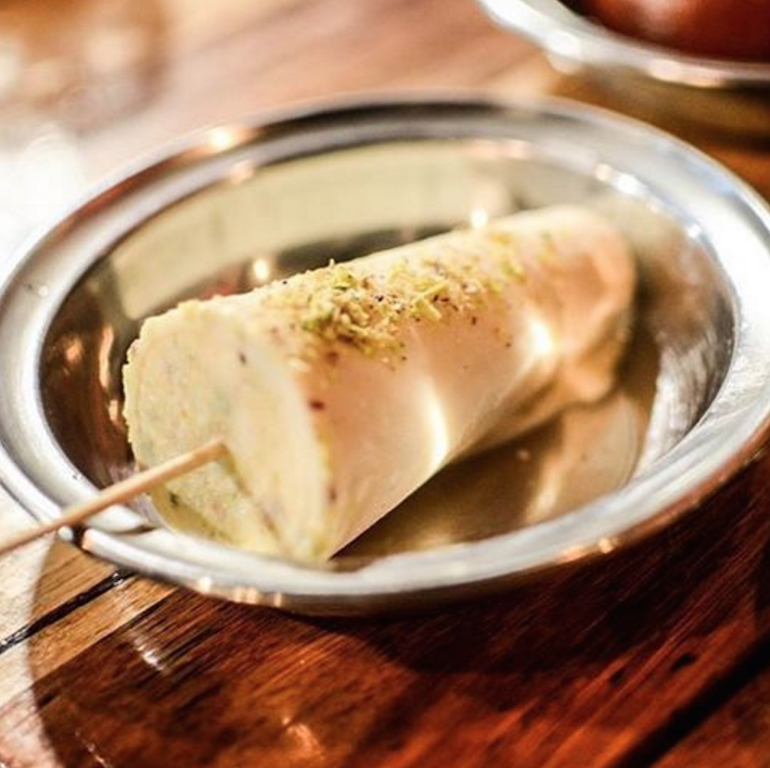
Photo courtesy of @thearchway on Instagram
In layman’s terms, kulfi is the Indian counterpart of ice cream. However there are several differences between kulfi and ice cream, predominantly in the contexts of flavor and texture.
Roadside kulfi is often served in its classic mold or with a decadent topping to create kulfi falooda, a type of ice cream float made with a base of rose syrup sauce, cooked vermicelli noodles, and basil seeds.
Pani Puri (pronounced pah-nee poo-ree)
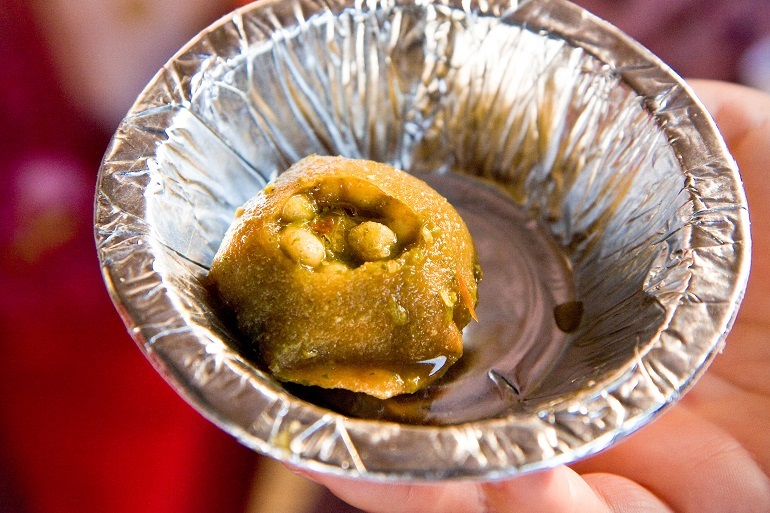
Photo courtesy of Garrett Ziegler on Flickr
Also known in certain parts of India as gol gappa (pronounced goal gup-puh), puchka (pronounced pooch-kah), and/or gup chup (pronounced goop choop), pani puri is considered the national symbol of Indian street food.
The dish consists of miniature puri shells (unleavened deep fried pieces of bread with semolina added to the dough) that have been hollowed out and traditionally stuffed with a seasoned mixture of mashed potatoes to which smashed chickpeas and/or bean sprouts are occasionally added.
The stuffed puri shells are garnished with an optional assortment of toppings including tamarind and mint chutney, finely chopped green chilies, and diced onions. The final touch is the pani, which is typically flavored with tamarind paste and chaat masala.
When recreating this dish at home, you’ll find that almost a pitcher full of the pani tends to get left over, so a great way to make the most of it is by converting the leftover pani into a cocktail.
Pakora/Pakoda (pronounced puh-koh-rah or puh-koh-duh)
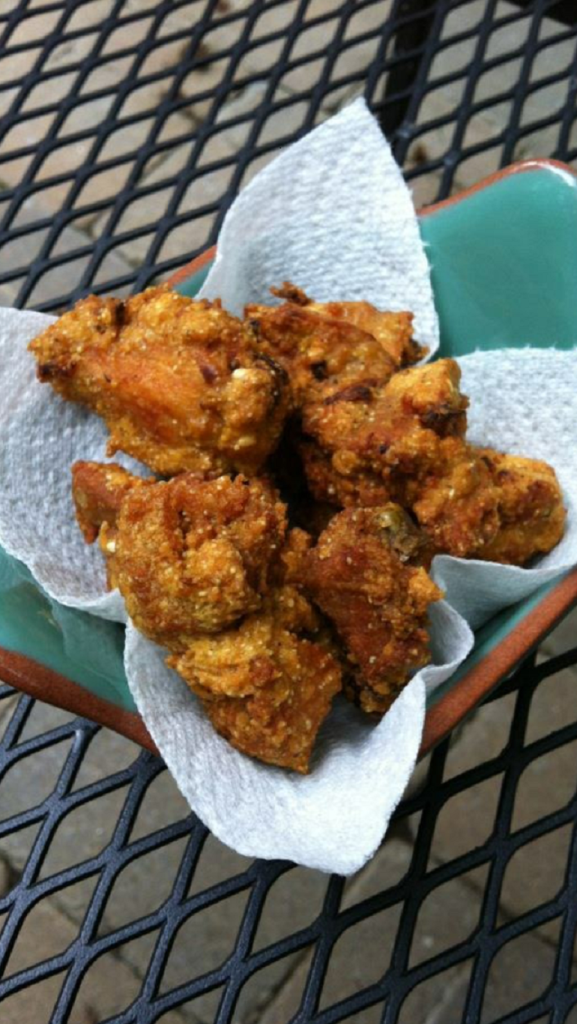
Photo courtesy of Suneeta Mishra
One of the easiest street foods to replicate at home, the pakora is a fritter made by dipping vegetable and/or meat pieces in a chickpea flour-based batter and then deep frying them into golden brown perfection. Pakora is served with an array of sauces, usually tamarind chutney and mint chutney or Maggi ketchup – but I’m here to advocate for good ol’ Sriracha (still seriously considering changing my name to Srirachashti) which will also do the trick.
Fish and chicken are the most common meats that are used in pakora making. The most common vegetables for dipping include onions, eggplant, cauliflower, and large green chili peppers.
Pav Bhaji (pronounced pao bhaa-jee)
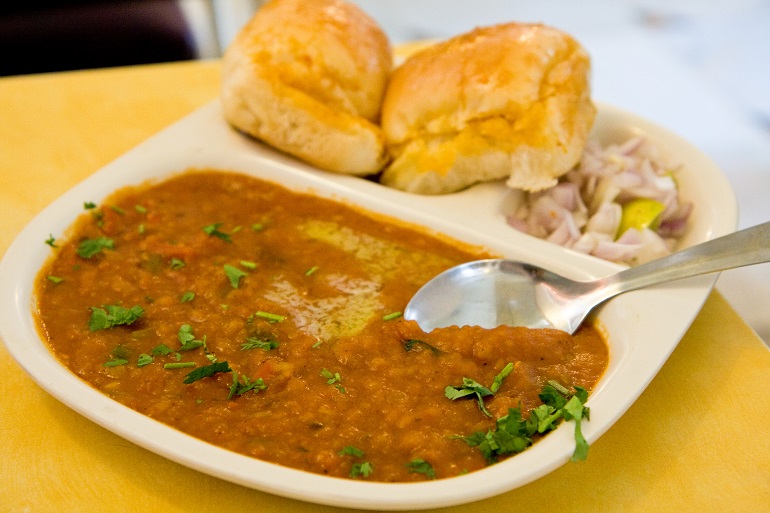
Photo courtesy of Garrett Ziegler on Flickr
Originating from the Indian state of Maharashtra, pav bhaji is a blend of mashed vegetables in a tomato-based gravy cooked on a tava (flat griddle) and served with a buttered batch-style bread roll.
Pav bhaji fairly resembles an Indian vegetarian version of a Sloppy Joe. In fact, a non-vegetarian version of pav bhaji is made with kheema (curried ground meat) and commonly referred to as kheema pav.
Samosa (pronounced suh-moh-sah)
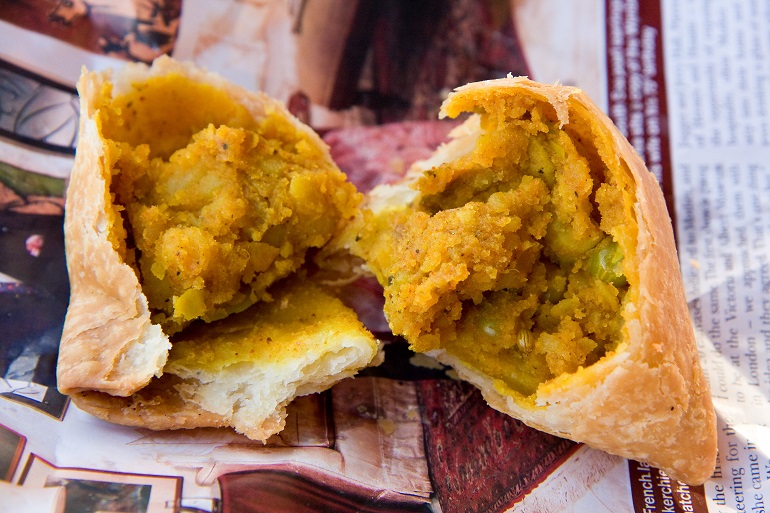
Photo courtesy of Garrett Ziegler on Flickr
In a nutshell, or should I say in a phyllo dough crust shell (hehe bad joke), samosas are the empanadas of the Eastern Hemisphere. Commonly found throughout South Asia, the Middle East, the Mediterranean, and parts of Africa, samosas are a mixture of seasoned potatoes, peas, and onions wrapped in a shell made of phyllo dough and then fried or baked. Samosas are the perfect finger food for cocktail parties or any occasion really.
Variations of samosas include ground meat and/or paneer.
Vada (pronounced vuh-dah)
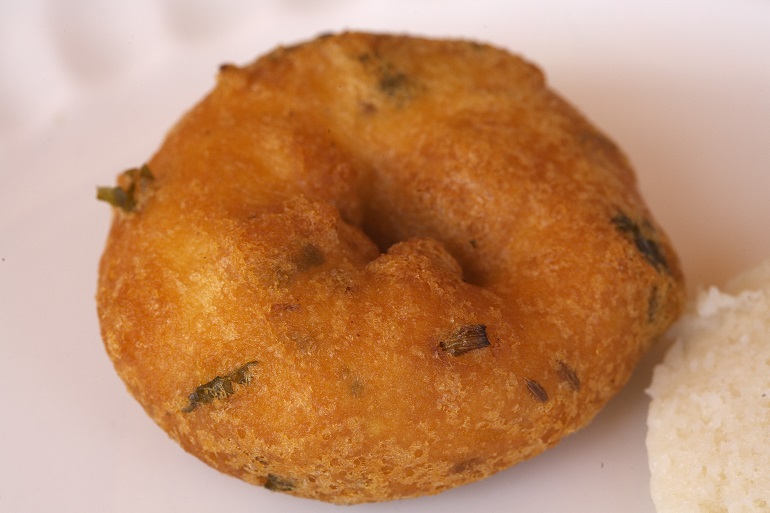
photo courtesy of Charles Haynes
You know that one deep-fried dish your mom used to make all the time growing up that you’d cautiously watch from the sidelines, anxiously eyeing the oil-dripping pieces, waiting for them to cool enough to snatch?
Well those are vadas for ya. Vadas are one of those snacks that, whether you’re 5 or you’re 50, will always scream comfort food, and like Lays, I betcha can’t have just one.
Vadas refer to a generic term for fritter snacks, however the one I am referring to is shaped like a donut and the batter is made out of lentils. The super sludgey-yet-grainy lentil batter is formed into blobs which are plopped into hot oil to create fritters.
They can be found served alongside other South Indian snacks – typically idlis (pronounced as id-lees) and dosas. Or they can also be found floating in a piping hot bowl of sambar (pronounced saam-bhur) or in a flavorful yogurt sauce which is a separate dish in itself known as dahi vada (pronounced dhuh-hee vuh-duh).
The best reason to try vadas is that they’re not at all spicy – unless you’re joining the Mishra family for tapas, in which case there will always be green chili chunks in your vadas because we intentionally want to see your face turner redder than Maggi ketchup and to watch you eyes pop out of your head and smoke to come out of your ears.
Vada Pav (pronounced vuh-dah pao)
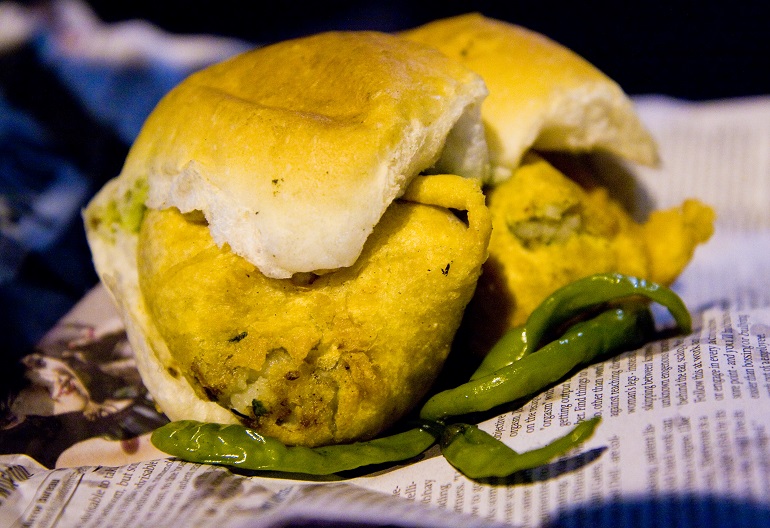
Photo courtesy of Garrett Ziegler on Flickr
One of the less spicy (depending on whether or not green chili peppers are involved) street foods out of this list, vada pav is a piece of deep-fried, carb-laden, vegetarian-friendly heaven. The dish consists of a potato patty rolled in garbanzo bean flour, then deep-fried, and sandwiched in between two bread buns which is then served alongside one or two chutneys or sauces.




